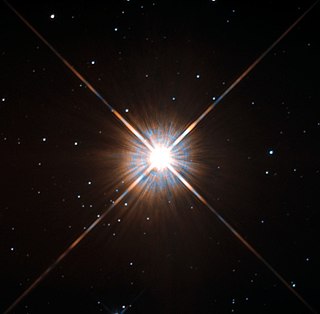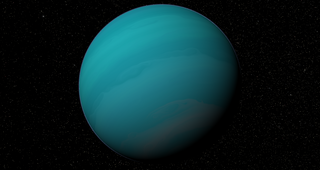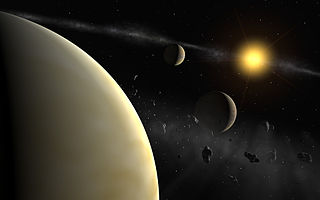
A red dwarf is the smallest kind of star on the main sequence. Red dwarfs are by far the most common type of fusing star in the Milky Way, at least in the neighborhood of the Sun. However, due to their low luminosity, individual red dwarfs cannot be easily observed. From Earth, not one star that fits the stricter definitions of a red dwarf is visible to the naked eye. Proxima Centauri, the star nearest to the Sun, is a red dwarf, as are fifty of the sixty nearest stars. According to some estimates, red dwarfs make up three-quarters of the fusing stars in the Milky Way.

Gliese 229 is a binary system composed of a red dwarf and the second brown dwarf seen by astronomers, 18.8 light years away in the constellation Lepus. The primary component has 58% of the mass of the Sun, 69% of the Sun's radius, and a very low projected rotation velocity of 1 km/s at the stellar equator.
Gliese 581 is a red dwarf star of spectral type M3V which hosts a planetary system, 20.5 light-years away from Earth in the Libra constellation. Its estimated mass is about a third of that of the Sun, and it is the 101st closest known star system to the Sun. Gliese 581 is one of the oldest, least active M dwarfs known. Its low stellar activity improves the likelihood of its planets retaining significant atmospheres, and lessens the sterilizing impact of stellar flares.

Gliese 876 b is an exoplanet orbiting the red dwarf Gliese 876. It completes one orbit in approximately 61 days. Discovered in June 1998, Gliese 876 b was the first planet to be discovered orbiting a red dwarf.

HD 69830 d is an exoplanet likely orbiting within the habitable zone of the star HD 69830, the outermost of three such planets discovered in the system. It is located approximately 40.7 light-years (12.49 parsecs, or 3.8505×1014 km) from Earth in the constellation of Puppis. The exoplanet was found by using the radial velocity method, from radial-velocity measurements via observation of Doppler shifts in the spectrum of the planet's parent star.

A Super-Earth or super-terran is a type of exoplanet with a mass higher than Earth's, but substantially below those of the Solar System's ice giants, Uranus and Neptune, which are 14.5 and 17 times Earth's, respectively. The term "super-Earth" refers only to the mass of the planet, and so does not imply anything about the surface conditions or habitability. The alternative term "gas dwarfs" may be more accurate for those at the higher end of the mass scale, although "mini-Neptunes" is a more common term.

An exoplanet is a planet located outside the Solar System. The first evidence of an exoplanet was noted as early as 1917, but was not recognized as such until 2016; no planet discovery has yet come from that evidence. What turned out to be the first detection of an exoplanet was published among a list of possible candidates in 1988, though not confirmed until 2003. The first confirmed detection came in 1992, with the discovery of terrestrial-mass planets orbiting the pulsar PSR B1257+12. The first confirmation of an exoplanet orbiting a main-sequence star was made in 1995, when a giant planet was found in a four-day orbit around the nearby star 51 Pegasi. Some exoplanets have been imaged directly by telescopes, but the vast majority have been detected through indirect methods, such as the transit method and the radial-velocity method. As of 24 July 2024, there are 7,026 confirmed exoplanets in 4,949 planetary systems, with 1007 systems having more than one planet. This is a list of the most notable discoveries.

Gliese 667 Cc is an exoplanet orbiting within the habitable zone of the red dwarf star Gliese 667 C, which is a member of the Gliese 667 triple star system, approximately 23.62 light-years away in the constellation of Scorpius. The exoplanet was found by using the radial velocity method, from radial-velocity measurements via observation of Doppler shifts in the spectrum of the planet's parent star.

Kepler-47c is an exoplanet orbiting the binary star system Kepler-47, the outermost of three such planets discovered by NASA's Kepler spacecraft. The system, also involving two other exoplanets, is located about 3,400 light-years away.

HD 219134 b is one of at least five exoplanets orbiting HD 219134, a main-sequence star in the constellation of Cassiopeia. HD 219134 b has a size of about 1.6 R🜨, and a density of 6.4 g/cm3 and orbits at 21.25 light-years away. The exoplanet was initially detected by the instrument HARPS-N of the Italian Telescopio Nazionale Galileo via the radial velocity method and subsequently observed by the Spitzer telescope as transiting in front of its star. The exoplanet has a mass of about 4.5 times that of Earth and orbits its host star every three days. In 2017, it was found that the planet likely hosts an atmosphere.
HIP 57274 d is an exoplanet orbiting the K-type main sequence star HIP 57274 about 84.5 light-years (26 parsecs, or nearly 8.022×1016 km) from Earth in the constellation Cetus. It orbits within the outer part of its star's habitable zone, at a distance of 1.01 AU. The exoplanet was found by using the radial velocity method, from radial-velocity measurements via observation of Doppler shifts in the spectrum of the planet's parent star.

K2-288Bb is a super-Earth or mini-Neptune exoplanet orbiting in the habitable zone of K2-288B, a low-mass M-dwarf star in a binary star system in the constellation of Taurus about 226 light-years from Earth. It was discovered by citizen scientists while analysing data from the Kepler space telescope's K2 mission, and was announced on 7 January 2019. K2-288 is the third transiting planet system identified by the Exoplanet Explorers program, after the six planets of K2-138 and the three planets of K2-233.
GJ 3470, proper name Kaewkosin, is a red dwarf star located in the constellation of Cancer, 96 light-years away from Earth. With a faint apparent magnitude of 12.3, it is not visible to the naked eye. It hosts one known exoplanet, GJ 3470 b.
Wolf 1069 b is an Earth-sized planet orbiting the red dwarf star Wolf 1069. Being located in the habitable zone of its star, Wolf 1069 b is considered a potentially habitable planet, as well as the sixth-closest Earth-mass planet orbiting within its star's habitable zone. The minimum mass of the planet, as measured by the radial velocity method, is 1.26 ME, while its radius is estimated at 1.08 R🜨. The equilibrium temperature of Wolf 1069 b is -23 °C.
Gliese 414, also known as GJ 414, is a binary system made up of an orange dwarf and a red dwarf, located about 39 light years from Earth, in the constellation Ursa Major. With an apparent magnitude of 8.31, it is not visible to the naked eye. The primary component of the system has two known exoplanets.

Gliese 414 Ab, also known as GJ 414 Ab, is a sub-Neptune exoplanet orbiting Gliese 414 A, an orange dwarf located 39 light-years from Earth, in the constellation Ursa Major. It is at least 7.6 times more massive than the Earth and is 3 times larger, having a diameter of 37600 km. It orbits its host star at a distance of 0.24 astronomical units (36,000,000 km), completing one revolution every 51 days. The distance of Gliese 414 A b from its star makes it to be located in the inner part of the optmistic habitable zone, and the planet has a equilibrium temperature of 35.5 °C.
GJ 3929 b is a confirmed exoplanet located 52 light-years away orbiting the red dwarf star GJ 3929. It is an Earth-sized planet, having a radius only 9% larger than that of Earth. It orbits its star at a distance of 0.0252 astronomical units (3,770,000 km), being located in the Venus zone of its star, and completes one orbit around it every 2 days and 15 hours. Because of the proximity of its star, and its low mass, GJ 3929 b is classified as a Venus-like planet, having an equilibrium temperature of around 300 °C and receiving planetary insolation 17 times more intense than Earth receives from the Sun.

GJ 3929, also known as Gliese 3929 and TOI-2013, is a red dwarf star located 51.6 light-years from Earth, in the constellation Corona Borealis. With an apparent magnitude of 12, it is not visible to the naked eye. In 2022, two exoplanets were detected orbiting the star.
HD 63433 c is a mini-Neptune exoplanet orbiting the Sun-like star HD 63433. It is the outermost planet in its planetary system, being located 0.1448 astronomical units (21,660,000 km) from its star, and completing one orbit every 21 days. Despite being the outermost planet in the system, it is still located close to its star, meaning that its temperature is hot, being estimated between 267 and 406 °C. HD 63433 c is about 2.7 times larger than Earth and 15.5 times more massive, but still smaller and less massive than Neptune. In 2022, a study showed that its atmosphere, made up of hydrogen, is being evaporated by the strong radiation from its star, causing it to slowly turn into a super-Earth planet.















